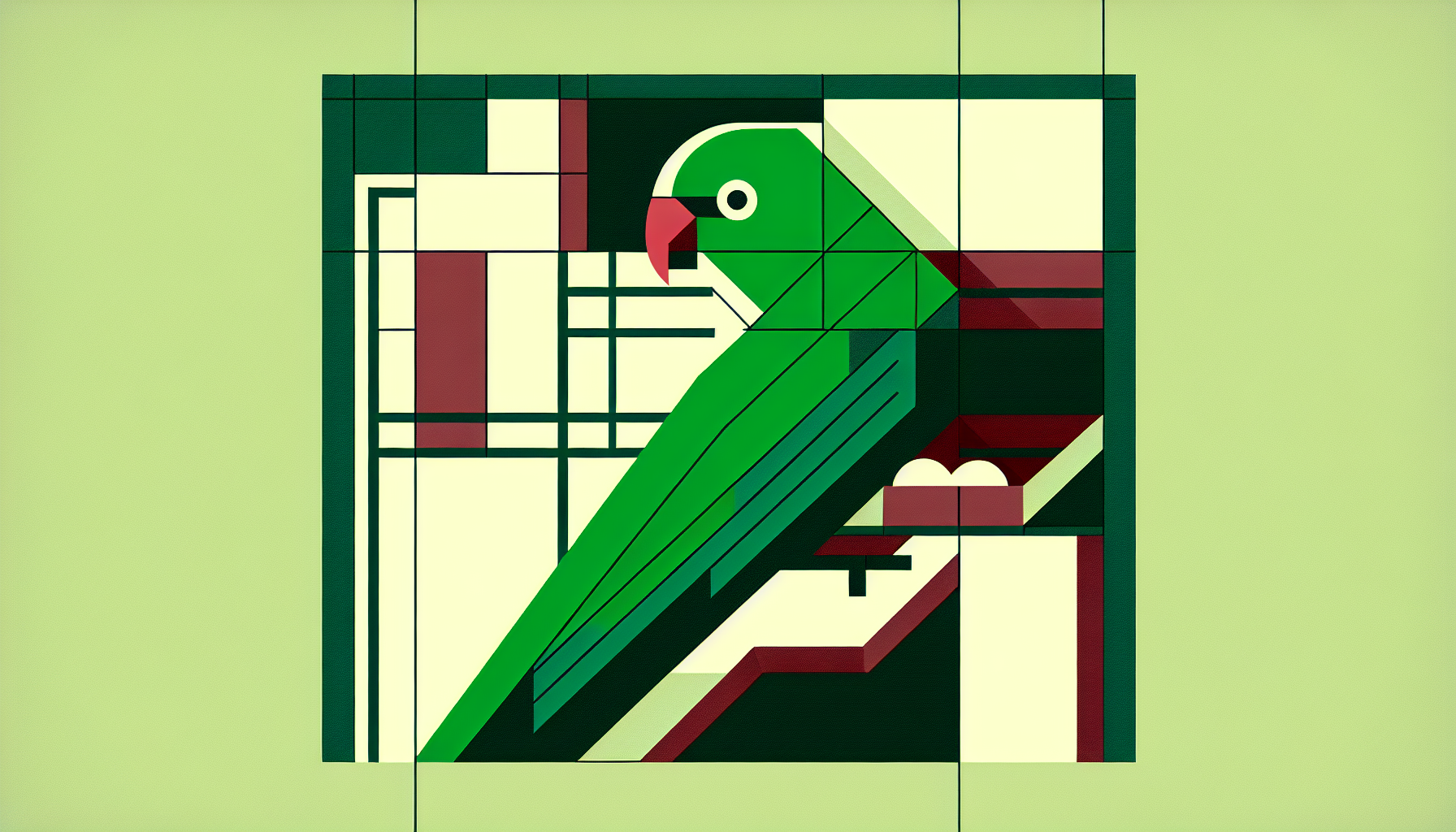Table of Contents
Red Rumped Parrot Care
Looking after a red-rumped parrot isn’t just about feeding and cleaning; it’s about keeping their minds and hearts happy. Let’s break down how to give these colorful characters the best life possible.
Keeping Their Minds Busy
Red-rumped parrots are smart cookies. They need activities that keep their brains buzzing and mimic what they’d do in the wild. Think of it like giving them puzzles to solve and games to play.
Fun Stuff for Their Brains:
- Toys: Mix it up with toys they can chew, shred, or mess around with. Swap them out regularly so they don’t get bored.
- Foraging Games: Hide treats in toys or around their cage to get them hunting like they would in nature.
- Playtime: Spend time playing games or training them. It keeps their minds sharp and builds your bond.
| Fun Activity | What It Does |
|---|---|
| Toys | Chew, shred, and play |
| Foraging Games | Hunt for treats |
| Playtime | Games and training |
For more tips on keeping your parrot’s brain busy, check out our parrot care guide.
Making Friends and Bonding
Red-rumped parrots are social butterflies. They love hanging out with their flock, which can be other birds or you. If you can’t have more than one bird, make sure to spend lots of time with your feathered buddy.
Ways to Bond:
- Hand-Feeding: Feeding them by hand can make them trust you more.
- Petting: Gentle strokes and pets can be super soothing and help you get closer.
- Chatting and Singing: Talk or sing to them regularly. It makes them feel part of the family.
| Bonding Activity | Why It’s Good |
|---|---|
| Hand-Feeding | Builds trust |
| Petting | Soothing and bonding |
| Chatting and Singing | Makes them feel loved |
Remember, red-rumped parrots need lots of toys and attention to stay happy. They get bored easily, so keep things interesting (Bird Cages Now). For more on parrot care, check out our articles on parrot care 101 and baby parrot care.
By keeping their minds active and spending quality time with them, you’ll ensure your red-rumped parrot is living their best life.
Red Rumped Parrot Diet
Feeding our red rumped parrots right is key to keeping them happy and healthy. Let’s break down what these colorful birds need, from seeds and grains to fresh fruits and veggies.
Seeds and Grains
Seeds and grains are a big part of a red rumped parrot’s diet. Think of it as their main course. A good mix includes canary seeds, sunflower seeds, hemp seeds, millets, and oats. Adding a bit of wheat germ oil to the mix can boost nutrition, keep their feathers shiny, and help prevent egg binding in hens. Just a half teaspoon of wheat germ oil per pound of seed mix does the trick.
| Seed/Grain Type | Benefits |
|---|---|
| Canary Seeds | High in protein |
| Sunflower Seeds | Rich in fats and oils |
| Hemp Seeds | Omega-3 and omega-6 fatty acids |
| Millets | Easily digestible carbohydrates |
| Oats | Fiber and vitamins |
To keep things balanced, mix in some pellets. They should make up about half of their diet. This ensures they get all the nutrients they need.
Fresh Fruits and Vegetables
Fruits and veggies are like the side dishes that pack a punch of vitamins and minerals. Our red rumped parrots love a variety of raw greens and veggies. Try small shreds of spinach, endive, lettuce, chickweed, broccoli tops, and carrot tops. Other good options include green beans, peas, carrots, and corn on the cob.
| Vegetables | Benefits |
|---|---|
| Spinach | Rich in iron and calcium |
| Broccoli Tops | High in vitamin C |
| Carrot Tops | Source of vitamin A |
| Green Beans | Good for fiber |
| Peas | Good protein source |
Fruits are more like dessert—delicious but in moderation. Small pieces of apples, pears, oranges, and other seasonal fruits are great treats. They should make up about 40% of their diet.
| Fruits | Benefits |
|---|---|
| Apples | Fiber and vitamin C |
| Pears | Hydration and vitamins |
| Oranges | High in vitamin C |
| Seasonal Fruits | Variety of nutrients |
For more tips on keeping your parrot in top shape, check out our articles on parrot care and parrot beak care. Good food means happy, healthy birds.
Health Concerns for Parrots
Common Avian Emergencies
Taking care of our red rumped parrots means being ready for health emergencies. Spotting the signs early can save their lives.
Hypocalcemia Syndrome: This condition often affects African Grey parrots. Look out for clumsiness and seizures. Quick treatment with calcium gluconate and diazepam is crucial.
Respiratory Distress: Breathing problems can come from lung disease, blocked airways, or belly issues affecting the air sacs. Treatment usually includes oxygen, antibiotics, and other supportive care. The use of bronchodilators and corticosteroids is debated.
Hemorrhage: Injuries are the main cause of bleeding in birds. Minor cuts like bleeding feathers, broken toenails, and wing tips are common and treatable. Serious injuries involving major blood vessels or internal organs need immediate care (Drexotic).
| Emergency Type | Common Symptoms | Immediate Treatment |
|---|---|---|
| Hypocalcemia Syndrome | Clumsiness, seizures | IV calcium gluconate, diazepam |
| Respiratory Distress | Trouble breathing | Oxygen, antibiotics, supportive care |
| Hemorrhage | Bleeding from feathers or nails | Stop bleeding, treat injury |
Preventing Poisoning and Toxicity
Keeping our parrots safe from poisoning is key. Various substances can be harmful to our feathered friends.
Heavy Metal Toxicity: Lead poisoning is a common issue. Symptoms include dullness, drooping wings, clumsiness, and seizures. Keep their environment free from lead-based items.
Pesticides: Insecticides and rodenticides, especially organophosphates and carbamates, can poison parrots. Signs of poisoning include loss of appetite, weakness, lack of coordination, and increased breathing problems. Make sure their food and water are clean.
| Toxin Type | Common Sources | Symptoms |
|---|---|---|
| Heavy Metals | Lead-based items | Dullness, wing droop, seizures |
| Pesticides | Contaminated food/water | Loss of appetite, weakness, breathing issues |
By staying alert and informed about these health concerns, we can keep our parrots happy and healthy. For more tips, check out our guides on parrot care 101 and parrot feather care.
Housing and Cage Needs
Making sure our red rumped parrots have the right home setup is key to keeping them happy and healthy. A good cage with fun stuff to play with can turn their space into a little slice of heaven.
Cage Size and Setup
Red Rump Parakeets need a big enough cage to match their lively nature. According to Bird Cages Now, here’s what you’re looking at:
| Cage Feature | Measurement |
|---|---|
| Length | 30 inches |
| Width | 20 inches |
| Height | 20 inches |
| Bar Spacing | ½ inch |
The right cage size gives our parrots room to stretch their wings without feeling cramped. Apart from a roomy cage, the basics like perches, feeders, and water dishes are a must.
Toys and Enrichment
Keeping our parrots entertained and engaged is a big deal. These smart and social birds need things to do to keep them happy. Boredom is the enemy, so let’s load up their cage with fun and interactive items.
Here’s what you can throw in there:
- Chew Toys: Think wood blocks and paper rolls. These satisfy their need to gnaw and keep their beaks busy.
- Climbing Ladders: Perfect for a good workout and keeping them on the move.
- Bird Baths: Regular baths keep their feathers in top condition. More about this in our feather care guide.
- Foraging Toys: These get them thinking and mimic how they hunt for food in the wild.
According to Bird Cages Now, having at least two birds can help mimic natural social interactions and cut down on stress. Variety in toys and activities keeps them engaged, avoiding those dreaded birdie blues. Check out parrot care 101 for more on keeping things fun.
Setting up a well-rounded environment isn’t just about being nice—it addresses their mental and physical needs, giving our red-rumped pals a fulfilling life.

